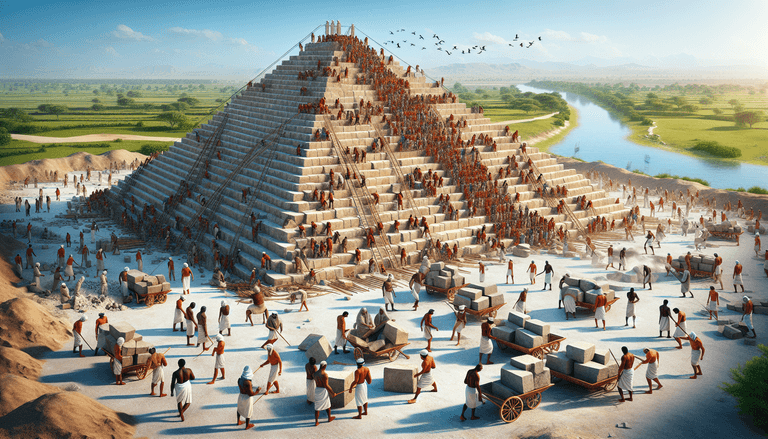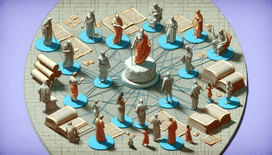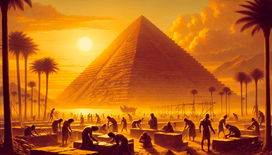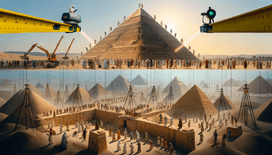Ah, the Great Pyramid of Giza! One of the seven wonders of the ancient world, and still standing tall after nearly 4,600 years. But what if this monumental task had been equipped with modern project management software? Could it have transformed the sands of ancient Egypt into the Silicon Valley of antiquity? Let’s slide down this pyramid-shaped rabbit hole and take a look, shall we?
The Pharaoh’s Plan Without a File Cabinet
So, picture this: It's 2580 BCE, and Pharaoh Khufu decides he wants a house that says, “I’m the King of this desert.” While the ancient Egyptians had undeniable talent, they weren't exactly working with Microsoft Project or Trello boards. Instead, Khufu probably used a combination of papyrus scrolls and shouted orders from a high place. Not exactly the most reliable method, especially when the wind picked up!
Enter project management software, a tool that not only could enhance ancient Egyptian efficiency but would also likely have left them more time to perfect the ultimate smoky eyeliner. With its aid, labourers could have tracked how many limestone blocks they laid each day, set milestones for when the outer casing would shine like the god Ra, and even had Gantt charts to plan the perfect ramp heist.
Breaking down the Pyramid into Achievable Steps
Building a pyramid isn't just "stack and pray"; it's a project that requires coordination on a monumental scale. Using modern technology, the Egyptians could have broken down the immense task into manageable chunks. Assign a smaller work gang to each section, schedule tasks nonchalantly, and update progress so Pharaoh wouldn’t have to shout through a cone made from papyrus.
Imagine the treasurer’s digital dashboard highlighting potential budget overages on precious copper chisels due to workers getting chisel-happy. The logistics overseer could ensure a smooth supply chain of not-so-luxurious luxuries, like grain rations for the workers. And let's not forget, the all-important trackers for the diet of the sacred cats that roamed the site, keeping the mouse population respectful.
Navigating the Workforce a Few Thousand Strong with a Click
Managing a workforce of 20,000 is no snip of the scissors even today, but with project management software, Khufu’s organisers could have implemented task allocations as skillfully as choreographing a flash mob at the temple courtyards. Need to raise workforce morale? Send a bulletin from the Pharaoh’s digital RAM account proclaiming a festival week with free Sphinx rides! Need a worker's status right on the whippy papyrus? No problem, just a few hieroglyphic strokes away.
Moreover, with advanced software, surprise inspections by overseers could be replaced by sneaky "activity reporting columns". Say goodbye to surprise slumps after a hieroglyph-heavy night!
Keeping Khufu in the Loop, Remotely!
Let’s not forget our dear Pharaoh, who wanted to ensure the grandeur of his afterlife abode while juggling projects like convincing the court of the value in pyramid real estate. Project management software would allow him to monitor progress from anywhere, assuming "anywhere" involved a camel ride’s distance. Khufu could 'virtually' wander around the construction site while sipping on fermented grape juice.
Alerts for pyramid project progress might have even spared Khufu’s subjects from several impromptu "ensuring proper motivation" speeches, accompanied by that frightening hand gesture every Pharaoh mastered. After all, nobody wanted to see Khufu angry – likely as terrifying as a tomb tour in pitch blackness.
From Stumbling Stones to Textbook Triangles
So, there you have it, dear reader. The building of the Great Pyramid could have been an altogether more civilised affair with the nifty implementation of project management software. Sure, it might have denied future historians from romanticising the hard labour of the ancient world, but it certainly would have prevented a hieroglyphic paperwork mess.
In this playful twist in the sands of time, one can't help but wonder: if only those old world wonders had a dash of new world wizardry in their tool kits, who knows what mysteries would unfold? Perhaps, just perhaps, productivity reports would have revealed the true secret behind their monumental success: a focus on being well-blocked and chiselled for centuries to come!







